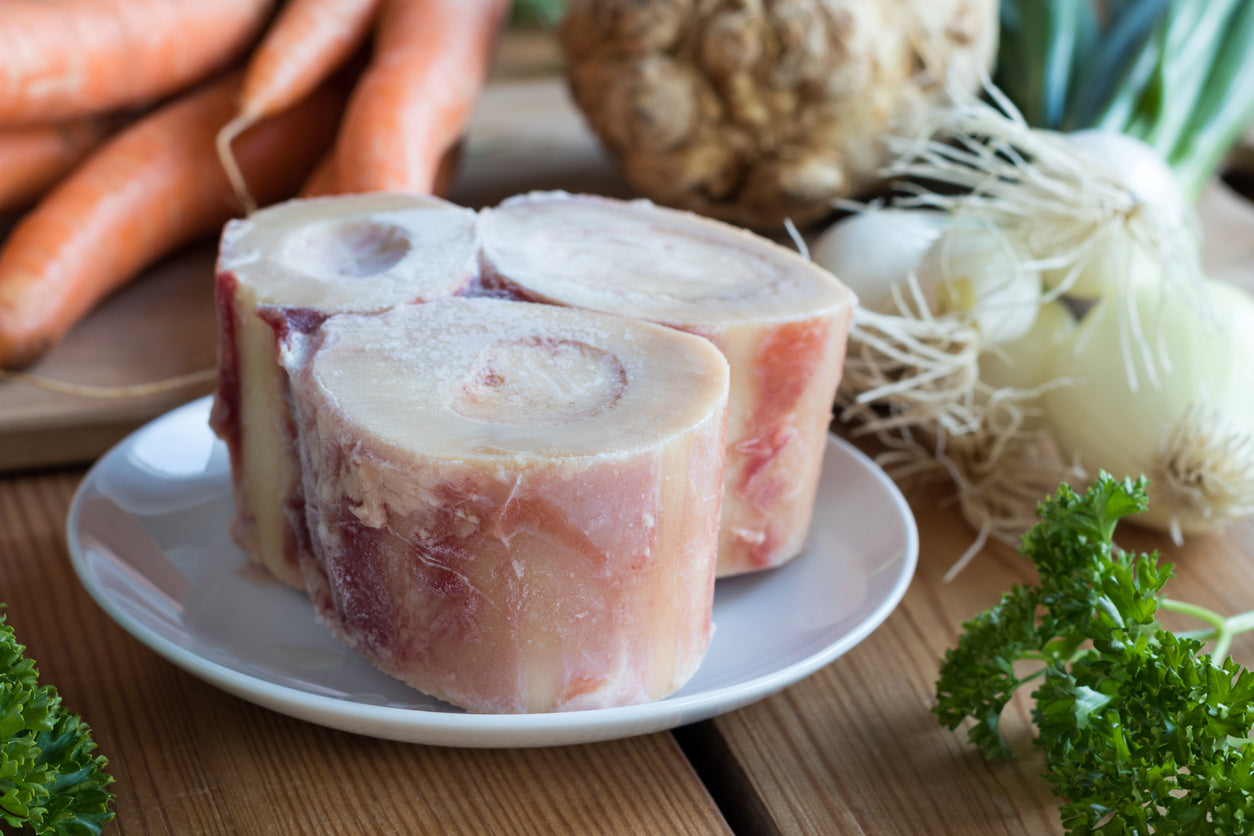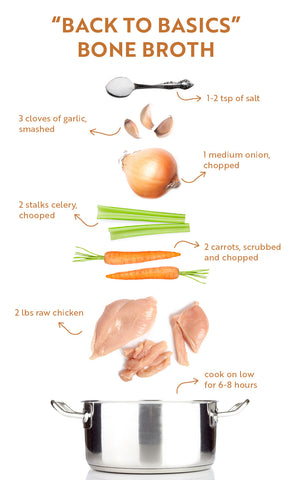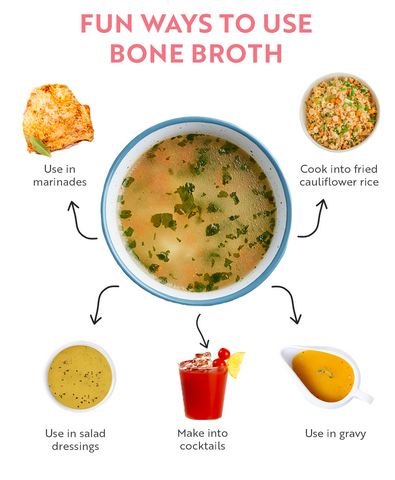
How to Make Bone Broth
Adding bone broth to your diet is a fantastic way to gain incredible health, wellness, and beauty benefits. Learning to make this pot of gold at home is a must with a list of healing properties that seem never-ending. There are plenty of options to meet your lifestyle needs, from the cooking tools to vegetarian and keto preferences. Here’s everything you need to know to whip up your batch of broth.
Best Bones for Bone Broth
When making your bone broth, you want to use the healthiest ingredients possible. That’s why I’m particular about using bones from organic, pastured, and grass-fed animals. These options are the superior choice because they are more nutrient-dense and come from healthier animals from an environment with as few toxins as possible. If you’re on a tighter budget, no worries, look for the highest quality bones you can afford. You can use the bones from just about any quality meat you like but try to be picky to ensure the most significant benefits—select bones with a lot of cartilage. Collagen in cartilage breaks down into gelatin bone broth. Great choices to scout for include: beef, bison, chicken, duck, goose, lamb, pork, turkey, and venison. Contact your local farmer, Whole Foods butcher, or head to your local farmer’s market if you can!
The best portions for your bone broth are the beef knuckles, joints, feet, and marrow bones. A calf or cow's foot is extremely rich in cartilage, while neck bones are also an excellent choice. A cartilage-rich pig’s foot makes a great addition to any broth recipe without affecting the flavor. Meaty bones such as oxtail, shank, and short ribs add a ton of flavor to bone broth. If you're using chicken or turkey, use the full carcass, neck, back, and feet. Chicken feet are the best source of gelatin and provide tremendous benefits when making your gelatin bone broth.
Cooking Tools for Bone Broth at Home
Don't worry; there's no need to have any fancy cooking equipment to make your tasty bone broth. As a matter of fact, I have several options to make it easy for you, no matter what you already have in your kitchen.
Bone Broth in a Slow Cooker
The great thing about a slow cooker is” the set it and forget it” benefit. If you’re busy or away from home all day, it’s the ideal way to make bone broth. Slow cooker water won't evaporate as it does in a stockpot. Most slow cookers are smaller than a 5-gallon stockpot, so when making your bone broth in a slow cooker, remember to adjust the number of vegetables and bones according to the size of your cooker. Make sure to cover the ingredients with water and turn the slow cooker to low.
Bone Broth in a Stock Pot

You can just as successfully make your bone broth in a stockpot on your stovetop. Most of us have a large stockpot in our kitchen cabinets, making this the perfect method. A 5-gallon stock pot allows you to make the most broth at once, but you can simply cut down the number of bones and vegetables you’re cooking with a smaller pot. Just don’t forget to check your liquid level occasionally if you choose this option. Make sure you always have enough water to cover the bones and veggies throughout the process.
Steps for Making Bone Broth in a Stockpot and Slow Cooker
- Place the vegetables, garlic, bones, and bay leave into a stockpot or slow cooker. Sprinkle on the salt, drizzle with vinegar, and add enough water to cover everything by an inch. Cover the pot.
- Cook on low for 12 to 24 hours for beef bone broth or about 6 to 8 hours for chicken or turkey, skimming the broth occasionally.
- Pour the broth through a fine strainer and discard the solids. Taste the broth and add more salt if needed.
- Chill the broth. It will keep for three days in the fridge and three months in your freezer.
Bone Broth in a Pressure Cooker
Pressure cookers are the quickest way to make bone broth. So, what do I recommend?
As far as pressure cookers go, the Instant Pot is one of the handiest gadgets on the market. You can brown and sauté food in it as well as using it as a pressure cooker—and you can use it as a slow cooker, too. The options are limitless and allow you to add many yummy ingredients to your bone broth in minutes. I have a delicious chicken bone broth recipe you need to try if you plan to make it in a pressure cooker!
Steps for Making Bone Broth in an Instant Pot or Pressure Cooker
- Place the vegetables, garlic, bones, and bay leaves into your Instant Pot or pressure cooker.
- Sprinkle on the salt, drizzle with vinegar, and add enough water to cover everything by an inch.
- Lock the lid of your pressure cooker in place.
- Cook on high for 90 to 120 minutes for chicken or turkey bones and about 2 to 3 hours if you’re using beef bones.
- Turn off the pressure cooker, quick release the pressure, and let the pressure cooker cool down until it’s ready to open.
- When your broth is cool, just strain it, and you're ready to go.
Reheating Your Bone Broth
Whether you're reheating your broth from the fridge or freezer, I highly recommend avoiding your microwave. Why spend all the time and effort to get the most nutrients out of your bones, then turn around and nuke them all out, right?
The easiest way is to reheat your broth on the stovetop. If you've frozen and stored your broth in a mason jar, you can simply add water to a saucepan, heat to medium, and place your open jar in the water to thaw. Allow a minute or two to boil then simmer to make sure you melt thoroughly. If you store your broth in a BPA-free plastic container or bag, place the frozen contents in the saucepan with a tablespoon or two of water and heat at medium-high until warm, then simmer for a few minutes. Alternatively, you can set out overnight to thaw your broth as well.
Why is Slow Cooking Vital to Bone Broth
Slow cooking draws out collagen by breaking down the bones and releasing essential nutrients and minerals. This gradual process is vital because it makes nutrient-rich collagen, gelatin, and glucosamine easier for your body to digest.
Why Isn’t My Broth Gelling
If you aren’t getting that jiggly jello look, there are a few tips to try to get you to that gel stage:
- Be mindful of your bone to water ratio: Adding too much water, or not enough bones will almost certainly affect your broth’s gelling capabilities. When you place the bones in your pot, remember to fill it with just enough water to cover your bones. It may even help to simmer your bones first, and then add your veggies in during the final three to six hours.
- Add in a bit of apple cider vinegar: The primary role of apple cider vinegar is to pull the minerals out of those bones. However, this also softens them, helping to release more gelatin into the water. It’s a great trick to get your gelatin to jiggle.
- Be Patient: It does take time for collagen to break down and dissolve into water, so be patient. Gelatin takes time. This means you should simmer your chicken bones (and skin) for at least eight hours and up to twenty-four hours. For beef bone broth, it can take up to forty-eight hours of simmering.
- Simmer, rather than boil: The liquid's temperature needs to reach at least 140 degrees Fahrenheit for your collagen to begin breaking down into gelatin. I find 210 degrees Fahrenheit, just below boiling, tends to be the ideal temperature for making the best tasting, nutrient-dense, gelatin-rich bone broth. At this temperature, you may notice a bit of bubbling here and there, but noticeably different from a boil. Boiling your broth can actually destroy the gelling properties of the gelatin, so keep an eye on it.
Why is Gelatin Essential
Gelatin is essentially your cooked collagen, the protein found mostly in the connective tissue and skin. They are pretty tough, so cooking these parts breaks the collagen down nicely into the gelatin form. Gelatin provides your body with the necessary source of collagen-building amino acids. In this gelatin state, amino acids are much more accessible for your body to absorb.
How Do I Incorporate Bone Broth Into My Diet
Adding gelatin-rich bone broth to your daily routine should be a lifestyle change, not a fad. The benefits of this collagen-rich broth are astonishing and well worth the commitment. From healing digestive issues to fading away those dreadful fine lines, finding ways to add it into your diet will become second nature. Here are some great ways to meet your goals:

Collagen protein powder supplements
Daily collagen supplements are a great, convenient option when you don’t have time to cook up a warm batch of gelatin bone broth. My delicious Super Chocolate Collagen Smoothie is one of my absolute favorite go-to choices if I’m short on time, on the go, or just needing a yummy chocolate fix. As with all collagen, this convenient supplement helps strengthen hair and nails and bring back your firm, radiant skin and a healthy glow. You can even add it to your morning coffee if you prefer. Collagen protein powders are easy to dissolve in hot or cold water, so your options are limitless. I even recommend adding it to your favorite recipes, soups, or salad dressings. Yep, it’s really that simple! And if you're out and about a lot, collagen protein powders are a dream. They're so easy to take with you anywhere and prepare without hassle. What more could you ask for?
Bone Broth Soup w/ Veggies
On top of all that gelatin you’ll be filling up on, load up on veggies. Seriously. Vegetables are beneficial for absolutely everything. Eating your spinach or other leafy greens will provide essential antioxidants that prevent collagen destruction. Adding red vegetables, like tomatoes and beets, help protect you from sun damage while boosting your collagen production. Thank you, lycopene.
Bone Broth Desserts
You read that right! I have a whole resource library of insanely tasty bone broth treats for you to try. And you won’t believe you’re filling your body with the incredible powers of gelatin bone broth. Add it to your frozen snacks, keto brownies, and more. You will love my coconut mocha collagen fat bomb recipe and won’t get enough of my Blackberry and Blueberry Bone Broth Popsicles.
Bone Broth Cocktails
In drinks including cocktails, such as my jaw-dropping twist on a Bloody Mary. Oh yes, I have many wonderful beverages for you to enjoy while sipping your bone broth benefits!
Bone Broth Options and Alternatives
I have options for everyone! If you're looking for a classic chicken bone broth or more alternatives to the usual beef or bone broth, give a few of these a try:
Fish Broth
Whether a dietary preference or short on time, give fish broth a try. Fish carcasses are smaller and much more delicate while providing a lighter broth base.
Like beef or chicken, fish bone broth is made by simmering fish carcasses or heads with water, veggies, and spices. However, since fish bones are smaller, you can draw out the nutrients in less time. In fact, some recipes require as little as one hour. You’ll reap all the same benefits in a fraction of the time. How does that sound?
Duck Bone Broth
Yes, please! This delicious option gives a richer flavor and is tasty in soup. If you have a bit of extra time, put your duck carcasses into a roasting pan and place it in a preheated 400º oven for roughly one hour until the bones are well browned. This step isn’t necessary, but it greatly enhances the flavor of duck bone broth.
Chicken Bone Broth
One of the most popular options is my quick and easy chicken broth. Here’s what you’ll need:
Prep time: 14 mins • Cook time: 90 mins to 2 hours / 2 to 3 hours • Yield: Varies, about 1 gallon
Ingredients:
- 2 or more pounds raw chicken bones/carcasses and additional wings, thighs or feet
- 2 unpeeled carrots, scrubbed and roughly chopped
- 2 stalks celery, including leafy part, roughly chopped
- 1 medium onion, roughly chopped
- 3 cloves garlic, peeled and smashed (optional)
- 2 teaspoons kosher salt
- 2 tablespoons apple cider vinegar
Directions:
- Place the vegetables, garlic, bones, and bay leaves into your pressure cooker. Sprinkle on the salt, drizzle with vinegar, and add enough water to cover everything by 1 inch. Put on the cover and pressurize.
- Cook on high pressure for 90 minutes to 2 hours for chicken or turkey, and 2 to 3 hours for beef.
- When the cooking time finishes, allow the Instant Pot to release naturally.
- Pour the broth through a fine strainer and discard the solids. Taste the broth and add more salt if needed.
- Chill the broth. It will keep for three days in the fridge and three months in your freezer.
Bottom Line of Making Bone Broth
There's no reason you shouldn't be incorporating this healthy, healing broth into your lifestyle with an array of cooking strategies and options to meet your needs. So, why wait? Flood your body with the powers of gelatin and reap health-promoting, anti-aging goodness today!








